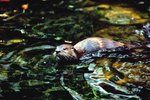
The Bermuda Triangle, not officially recognized by the U.S. Navy or U.S. Coast Guard, is an area of the Atlantic Ocean that encompasses nearly 500,000 square miles, its apexes at Bermuda, Miami, and San Juan, Puerto Rico. Famed for mysterious disappearances, the Bermuda Triangle abounds with wildlife, some of it endangered.
Coral
The only endangered coral species in the Bermuda Triangle, is, unfortunately, also one of the most important in terms of reef-building. The boulder star coral, which sprouts from closely packed nodules and develops into thick, wide columns or bulky boulders, is the foundation on which a thriving reef is built. Growing up to 40 percent larger than other coral species, infectious disease, human interference and hurricane damage have decreased the boulder star coral population by an estimated 50 percent since the 1990s.
Crustaceans
The Bermuda Triangle's only endangered crustacean is the Sterrer's cave shrimp. Found in Bermuda, the Bahamas and Cozumel, Mexico, this crustacean has a bright red body with distinguishing white bands on his legs at the joints. Dark, prominent eyes perch atop his long, rather pointed head.
Feathered Friends
Nine endangered bird species call the Bermuda Triangle home at least part of the year. Such birds include the Bahama swallow, the black-capped petrel, the Puerto Rican sharp-shinned hawk, the yellow-shouldered blackbird, the Puerto Rican parrot, the Puerto Rican broad-winged hawk, the Puerto Rican nightjar and the Puerto Rican plain pigeon. The Bermuda petrel, the national bird of Bermuda, also makes the endangered list. At one time an estimated 500,000 petrels flocked on Bermuda's islands, but they were driven nearly to extinction with the introduction of mammals such as dogs, cats, pigs and rats in the 1500s.
Fishes
Three fish swimming in the waters of the Bermuda Triangle have become endangered. The Nassau grouper, found only off south Florida, is particularly vulnerable to overharvesting, although currently no harvesting of this fish is permitted. With light base coloring and brown or reddish-brown vertical stripes, the markings on the Nassau grouper's head are in the shape of a tuning fork. Adults often congregate offshore around rocky reefs, while juveniles tend to remain close to shore. One of the more frightening of the Bermuda Triangle's endangered fish species is the scalloped hammerhead shark. The European eel rounds out the list of endangered fish.
Mammals
Four endangered mammals either live within the boundaries of the Bermuda Triangle or travel across it frequently. On land, the Bahamian lesser funnel-eared bat is found in the deciduous dry forests of Great Abaco and Watling in the Bahama Archipelago. Scampering about on land, the Bahama hutia is a hefty brown rodent weighing around 1.5 pounds. Once an important food source for native peoples, the hutia -- the only land mammal native to the Bahamas -- was thought to be extinct prior to his rediscovery in 1996. Cruising the waters of the Bermuda Triangle are the endangered North Atlantic right whale and the sei whale.
Receding Reptiles
Land-based endangered reptiles living within the bounds of the Bermuda Triangle include the Bahamas rock iguana and the central Bahamian rock iguana, the Bermuda skink and the monito gecko. Endangered turtles gliding through the warm waters and nesting on beaches in the Bermuda Triangle include the green turtle, the hawksbill turtle, the loggerhead turtle and the leatherback turtle.
References
- National Oceanic and Atmospheric Administration: The Bermuda Triangle
- Dutch Caribbean Nature Alliance: Boulder Star Coral
- ARKive: Sterrer's Cave Shrimp
- Ocean Wanderers: Bermuda Petrel (Pterodroma Cahow)
- Florida Fish and Wildlife Conservation Commission: Nassau Grouper: Epinephelus Striatus
- Animal Diversity Web: Chilonatalus Tumidifrons
- Bahamas National Trust: Bahama Hutia
Resources
Photo Credits
-
Comstock Images/Stockbyte/Getty Images




